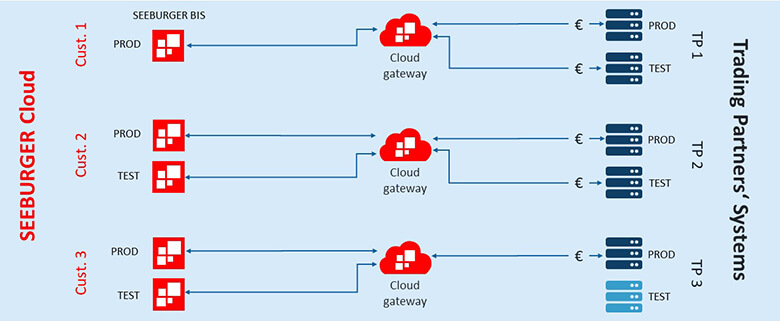Managing Trading Partners’ Master Data – New and Improved Service from SEEBURGER for its Cloud Customers

For existing SEEBURGER Cloud Service customers who already use our managed integration services, iPaaS services, communication services or services on a public cloud, managing your trading partners’ master data is now even easier, securer and more transparent. Let’s look at the advantages.
Customer satisfaction is our number one priority at SEEBURGER. In order to ensure that our customers really are satisfied, we stay in close contact with you and use your input to continually develop our services. Recently, we have been able to significantly improve how our cloud service customers manage their trading partners’ master data and include this as a fixed service component in our cloud offering. Not only does this make electronic data interchange (EDI) via SEEBURGER cloud services more cost-effective and transparent, it also makes it much easier.
New and improved trading partner master data management from SEEBURGER
- Lower costs and easier processes
A newly monthly flat fee replaces the previous process of charging by number of change requests. In the past, exchanging certificates with trading partners connected to a SEEBURGER cloud service was a little tricky. This new approach has not only simplified the process, but could even save our customers money.
- Manage EDI addresses simply yet securely over the internet
SEEBURGER operates a central communication gateway in the cloud to enable communication between our customers and their trading partners. It is accessible via public internet and is used to securely transport EDI messages between our customers and their business partners. In the gateway, the communication endpoints have each been given a unique EDI identifier (EDI address), which differs depending on the type of communication protocol used (e.g. AS2 or OFTP2). This means that a customer may need several different EDI addresses for different business partners.
In order for customers to exchange EDI messages smoothly over this gateway, SEEBURGER needs to create, activate and maintain EDI addresses. At the same time, there needs to be a connection between the cloud communication gateway and the customer’s EDI system(s), whether production or test systems. The settings on the customer’s system to connect and to process the data are independent of the communication gateway, and can still be set up and maintained there, which is useful for importing mappings or configuring processes.

How does managing trading partners’ master data work?
In order to set up – and maintain – an EDI connection to a trading partner, the customer merely needs to give SEEBURGER the name of a contact person at the receiving company. SEEBURGER then works with this contact person to arrange the best communication protocol, then the two companies exchange EDI addresses and any other relevant connection details. A business partner can also use several communication endpoints, if, for example, they have several production sites or to connect an additional test system.
SEEBURGER then creates a partner agreement which essentially links its customer’s preferred EDI address to their partner’s most appropriate EDI address for the agreed communication protocol. Once a connection test has been passed, the customer is notified that the set up is finished and the connection is active.
The time needed to set up a connection mostly depends on the availability of the contact person for the business partner. If the named contact person has not responded within two weeks, SEEBURGER reports this back to the customer. The customer is then responsible for requesting his business partner actively contacts SEEBURGER.
What does this SEEBURGER master data management service include?
Our trading partner master data management service carries a monthly fee, which is based on the number of active communication endpoints to your trading partners. The fee includes the initial setup of the communication endpoints for a customer’s cloud productive or test system on the gateway and includes AS2, OFTP2 and SFTP protocols. All requests to activate, deactivate or adjust trading partners’ master data are managed and executed centrally through the SEEBURGER service desk.
The monthly fee also includes renewing certificates due to expire and making typical master data changes due to system migrations (e.g. change of a host name or URL) on the SEEBURGER communication gateway.
The charge is made per partner endpoint, starting the the month following activation. If there is a partner endpoint which appears in several partner agreements (for example, to connect both a productive and test system for the customer to the same endpoint), the fee is only charged once. Customer 3 in figure 2, below, is a good illustration of this scenario.

Customers can terminate a partner agreement using the change request process. Once the last partner profile for a partner endpoint has been deactivated, the monthly maintenance fee for this partner endpoint is dropped from the following month onwards.
This service is designed for systems in normal operation and includes a maximum of three new partner agreements per week, in a maximum of three individual requests. The creation of new partner profiles on the gateway (onboarding) is done via a separate change request.
If a customer also wishes SEEBURGER to set up the communication endpoints on the EDI system, this can also be arranged through the change request process.
What are the advantages for SEEBURGER customers?
Our revised master data management service for trading partners has a number of advantages for our customers:
- Lower costs thanks to a plannable, more transparent monthly fee as well as a lower project outlay.
- Pay per use – the customer only pays for activated connections, which has a positive impact on an EDI project budget, especially in a ramp-up scenario.
- Higher stability with less risk of downtime for the transfer protocols.
- Considerably lower administration for the customer.
- Peace of mind. It‘s easier to follow a cloud approach as the SEEBURGER team takes on reponsibility for the connections.
How can SEEBURGER help you?
SEEBURGER cloud services make integrating partners’ systems and electronically exchanging data with them simple, transparent and secure. The SEEBURGER Business Integration Suite is a full, single-source solution with modular services which you can book and combine as and how you need them. There are many ways to deploy the SEEBURGER Business Integration Suite from a cloud. This may be an on-premises installation from your private cloud or from a public cloud, as an iPaaS from SEEBURGER, or as a fully-managed integration platform from the SEEBURGER Cloud.
Thank you for your message
We appreciate your interest in SEEBURGER
Get in contact with us:
Please enter details about your project in the message section so we can direct your inquiry to the right consultant.
Written by: Manuel Veith
Manuel Veith is a Presales Engineer for cloud and managed services at SEEBURGER. Manuel worked in the automotive industry from 2001 to 2021 where he spent the last ten years involved in subscription & pay per use business models. He recently joined SEEBURGER to combine his information systems degree with his professional experience in sales.





